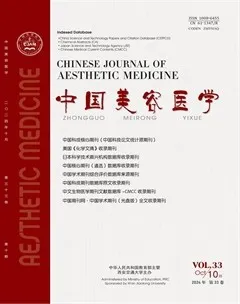研磨和拋光對二硅酸鋰玻璃陶瓷動態磨損行為影響的研究
[摘要]目的:研究模擬口腔環境下研磨和拋光對二硅酸鋰玻璃陶瓷動態磨損行為的影響,為口腔臨床操作提供參考。方法:制備直徑3 mm、長8 mm的二硅酸鋰玻璃陶瓷上試件和直徑20 mm、厚4 mm的二硅酸鋰玻璃陶瓷下試件各16個,將上、下試件隨機分為兩組,一組打磨至600目作為研磨組,另一組打磨至2 000目作為拋光組,每組8個樣本,在摩擦磨損試驗機將上、下試件組成一對摩擦副,在人工唾液、室溫環境、20 N載荷、轉速100 r/min、回轉半徑2.5 mm、勻速圓周運動的條件下進行50萬次循環磨損實驗。在整個磨損周期中選取10個循環節點,用三維形貌儀測量每個節點圓盤試件的磨損高度損失量并繪制相應磨損曲線,再利用掃描電鏡觀察相應磨損階段對應的磨損面微觀形貌。結果:整個磨損過程中,各節點測量值顯示研磨組二硅酸鋰玻璃陶瓷的磨損量均大于拋光組二硅酸鋰玻璃陶瓷的磨損量(P<0.05);兩組二硅酸鋰玻璃陶瓷的磨損曲線均呈現“跑合期”和“穩定磨損期”兩個磨損階段,研磨組的“跑合期”較拋光組的“跑合期”長,進入“穩定磨損期”的時間比拋光組遲。兩組試件的微觀形貌也呈現出與磨損曲線對應的兩階段規律。結論:在模擬口腔環境下,研磨組二硅酸鋰玻璃陶瓷的磨損量顯著高于拋光組,提示臨床應重視戴牙時修復體的充分拋光以降低磨損、延長修復體使用壽命。
[關鍵詞]表面處理;二硅酸鋰玻璃陶瓷;磨損;微觀形貌;拋光
[中圖分類號]R783.4 [文獻標志碼]A [文章編號]1008-6455(2024)10-0138-04
Wear Performance of Lithium Disilicate Glass-ceramic after Grinding and Polishing Treatments
WANG Xuesong1,2, ZHANG Shaofeng3,4, JIN Lei1
( 1.Department of Stomatology, Jinling Hospital, Affiliated Hospital of Medical School, Nanjing University, Nanjing 210016, Jiangsu, China; 2.Department of Stomatology, the First Affiliated Hospital of Anhui Medical University, Hefei 230022, Anhui, China; 3.Department of Expert, Xi'an Cunji Stomatological Hospital, University of Chinese Academy of Sciences, Xi'an 710000, Shaanxi, China; 4.State Key Laboratory of Military Stomatology, National Clinical Medical Research Center for Oral Diseases, Key Laboratory of Stomatology of Shaanxi Province, Department of Prosthodontics, School of Stomatology, Air Force Medical University, Xi'an 710032, Shaanxi, China )
Abstract: Objective To study the effects of grinding and polishing on the dynamic wear behavior of lithium disilicate glass ceramics in simulated oral environment, and provide reference for oral clinical operation. Methods Sixteen lithium disilicate glass ceramic cylinders with a diameter of 3 mm and a length of 8 mm and lithium disilicate glass ceramic discs with a diameter of 20 mm and a thickness of 4 mm were prepared, and the upper and lower test pieces were randomly divided into two groups. one group was polished to 600 mesh as the grinding group, and the other group was polished to 2 000 mesh with polishing cloth with synthetic leather polishing pad as polishing group, each group of 8 samples, in friction and wear testing machine The friction pair was composed and 500,000 cycles of wear test were carried out under artificial saliva, room temperature environment, 20 N load, rotation speed 100 r/min, radius of gyration 2.5 mm, and uniform circular motion. 10 loop nodes were selected in the whole wear cycle. The wear height loss of each node disc specimen was measured by three-dimensional shape analyzer and the corresponding wear curve was drawn. Then the scanning surface was used to observe the wear surface corresponding to the wear phase. Results During the whole wear process, the measured values of each node showed that the wear amount of the lithium disilicate glass ceramics in the grinding group was larger than that in the polishing group lithium disilicate glass ceramics (P<0.05). The wear curve shows two wear stages: "running period" and "stable wear period". The "running period" of the grinding group is better than the "running period" of the polishing group, the time to enter the "stable wear period" is later than the polishing group. The microscopic morphology of the two sets of specimens also showed a two-stage law corresponding to the wear curve. Conclusion In the simulated oral environment, the wear of lithium disilicate glass ceramics in the grinding group is significantly higher than that in the polishing group, suggesting that the clinical should pay attention to the adequate polishing after the prosthesis is worn to reduce wear and prolong the life of the prosthesis.
Key words: surface treatment; lithium disilicate ceramics; wear; microscopic morphology; polish
齒科陶瓷材料因其出色的美學特性、理想的生物相容性和優異的耐磨性能等優點已被廣泛應用于制作貼面、嵌體和冠橋等各種類型的修復體[1]。瓷修復體戴入口內后,長期的磨損是造成其崩瓷、折斷和天然牙過度磨損的主要原因[2]。研磨和拋光是臨床椅旁試戴時常用的兩種表面處理方式,以往關于表面處理方式對齒科陶瓷材料磨損性能影響的體外研究大多集中在固定循環節點下的磨損量對比[3-5],不能準確評價瓷修復體戴入口內后長期動態的磨損行為。因此,本實驗通過多節點監測,探究研磨和拋光對臨床常用的二硅酸鋰玻璃陶瓷動態磨損行為的影響,以期為椅旁戴牙時選擇合適的表面處理方式,改進二硅酸鋰玻璃陶瓷的磨損性能提供參考。
1 材料和方法
1.1 設備和材料:摩擦磨損實驗機(CH-2034Peseux,CSM,瑞士),場發射掃描電鏡(S-4800,日立,日本),三維形貌掃描儀(PS-50,Nanovea,美國),二硅酸鋰鑄瓷(IPS e.max Press HT,Ivoclar Vivadent,列支敦士登),自凝造牙粉(上海醫療器械),自動拋光機(UNIPOL-830,沈陽科晶自動化設備),義齒基托樹脂Ⅱ型(上海二醫張江生物材料),人工唾液(第四軍醫大學口腔醫院藥劑科)。
1.2 試件制備:按照熱壓鑄工藝要求,制備直徑20 mm、厚4 mm的有機玻璃下試件和直徑3 mm、長8 mm的有機玻璃上試件各16個。將上、下試件隨機分為兩組,一組陶瓷試件在自動拋光機下用SiC砂紙逐級打磨至600目作為研磨組,另一組逐級打磨至2 000目作為拋光組,每組8個樣本。
1.3 磨損測試:分別將研磨組和拋光組的二硅酸鋰玻璃陶瓷上、下試件組成一對“摩擦副”(n=6)。將“摩擦副”安裝在摩擦磨損實驗機的不銹鋼夾具中調平,使上、下待磨試件完全貼合接觸。在室溫條件下,向磨損容器中加入40 ml人工唾液,測試參數為加載力20 N、轉速100 r/min、回轉半徑2.5 mm,運動模式為勻速圓周運動。在整個50萬次循環中,選取10個節點,磨損至相應循環次數時暫停磨損試驗機,吸走人工唾液,在不拆卸“摩擦副”的情況下沖洗、吹干下試件并用二次印模法制取硅橡膠印模,使用三維形貌儀掃描硅橡膠印模(掃描范圍9 mm×9 mm,掃描步徑20 μm/s),并用分析軟件(Professional 3D,Nanovea)計算出磨損區的高度損失量,再根據磨損速率計算公式(V= )算出兩組試件相應的磨損速率,公式中V為磨損速率,△H為相鄰兩個測量節點的高度損失量,△N為兩個相鄰測量節點的循環次數差值。最后將每個測量節點的6個試件高度損失量、磨損速率的平均值與標準差用Origin軟件繪制出隨循環次數變化的動態磨損曲線。
1.4 微觀形貌觀察:選取研磨組和拋光組二硅酸鋰鑄瓷圓盤試件各2個,分別與二硅酸鋰圓柱試件配副,依據磨損曲線,分別在磨損“跑合期”“穩定磨損期”拆卸圓盤試件,置于去離子水中超聲清洗30 min,干燥、噴金后,掃描電鏡下觀察不同磨損階段下試件的表面微觀形貌。
1.5 統計學分析:運用SPSS 19.0軟件,利用重復測量資料的方差分析與LSD多重比較檢驗,比較各組及各個節點間磨損量的差異,采用獨立樣本的t檢驗比較兩組試樣在同一時間節點磨損量的差異,檢驗水準α均設為0.05(雙側)。
2 結果
2.1 兩組二硅酸鋰玻璃陶瓷磨損行為的宏觀衍化規律:研磨組、拋光組二硅酸鋰玻璃陶瓷下試件的磨損量見表1~2,動態磨損曲線如圖1~2。在50萬次磨損循環后,研磨組二硅酸鋰玻璃陶瓷的磨損量(37.63±1.38)μm顯著大于拋光組的(22.77±0.81)μm(P<0.05)。兩組試件的磨損量隨循環次數增加而增加,但其磨損行為在不同時期表現出不同的階段性特征:對研磨組試件各節點的磨損速率進行LSD檢驗結果顯示,10萬次循環節點前后的磨損速率差異有統計學意義(P<0.05),而從10萬次循環節點之后的各節點磨損速率差異無統計學意義(P>0.05),結合磨損曲線,可將研磨組二硅酸鋰玻璃陶瓷磨損曲線分為“跑合期”(0~10萬次)、“穩定磨損期”(10~50萬次)兩個特征性磨損階段。對拋光組試件各節點的磨損速率進行LSD檢驗結果顯示,5萬次循環節點前后的磨損速率差異有統計學意義(P<0.05),而5萬次循環節點之后的各節點磨損速率比較差異無統計學意義(P>0.05),結合磨損曲線,可將拋光組二硅酸鋰玻璃陶瓷磨損曲線分為:“跑合期”(0~5萬次),“穩定磨損期”(5~50萬次)兩個特征性磨損階段。
2.2 兩組二硅酸鋰玻璃陶瓷磨損行為的微觀形貌分析:研磨組二硅酸鋰玻璃陶瓷在跑合期時磨損面表現為密集的深犁溝狀弧形磨痕,犁溝間的間隔窄而起伏大,高倍鏡下可見二硅酸鋰玻璃陶瓷表面散在的剝脫及磨屑粘著現象;穩定磨損期時磨損面的犁溝狀磨痕較跑合期稀疏,犁溝間的間隔寬而起伏小。高倍鏡下可見磨損面較跑合期光滑,犁溝狀磨痕深度較淺。拋光組二硅酸鋰玻璃陶瓷高低倍鏡下跑合期的磨損面同樣較穩定磨損期的磨痕更為密集、深大。對比兩組的電鏡照片,研磨組因為試件的初始粗糙度大,所以無論是跑合期還是穩定磨損期,其磨損面的磨痕均較拋光組更為密集、深大。
3 討論
3.1 實驗條件的設定:瓷修復體進入口腔服役后,磨損性能是評價其優劣的一項重要指標。口內評價瓷修復體的磨損性能存在耗時長、影響因素多、失訪率高等缺點,相比之下,在體外利用摩擦磨損實驗機控制磨損實驗條件能夠準確、高效地研究單一因素對于齒科陶瓷磨損行為的影響[3,6],口腔臨床椅旁戴牙時,常需要對瓷修復體進行調牙合,常用的表面處理方式即為研磨和拋光處理。有學者在CSM摩擦磨損實驗機上用20 N加載力來評價金屬復合材料的磨損性能[7],同Preis V等[4-5]對齒科陶瓷磨損性能的研究類似,這些體外磨損實驗都是在固定循環節點下進行磨損量對比,缺乏系統性和全面性。因此,本實驗共選取10個循環節點,研究研磨和拋光對二硅酸鋰玻璃陶瓷動態磨損行為的影響。
3.2 動態磨損行為分析:“機械摩擦副”理論認為,材料的磨損具有時間依賴性,即隨著磨損周期的延長,摩擦副的動態磨損行為呈現出“跑合期”、“穩定磨損期”、“劇烈磨損期”三個階段[8]。相關文獻報道證實齒科長石質飾瓷在與天然牙(“瓷-牙”配副)以及長石質飾瓷與不銹鋼小球(“瓷-球”配副)磨損過程中均呈現出上述的“三階段”規律,然而在口腔臨床實踐中,“瓷-瓷”配副的磨損情況也較為常見,因此,本實驗將二硅酸鋰玻璃陶瓷上、下試件組成一對“摩擦副”,模擬口腔中上、下頜均為全瓷牙冠的磨損情況[9]。本實驗中,研磨組二硅酸鋰玻璃陶瓷呈現出跑合期(0~10萬次)、穩定磨損期(10~50萬次)的二階段磨損規律,拋光組二硅酸鋰玻璃陶瓷呈現出跑合期(0~5萬次)、穩定磨損期(5~50萬次)的二階段磨損規律。兩組試件的磨損面微觀形貌在“跑合期”時表現為均勻密集的深犁溝狀弧形磨痕,進入“穩定磨損期”,犁溝狀磨痕逐漸變淺,磨損面趨于光滑。兩組試件的宏觀磨損量和微觀磨損形貌隨循環次數增加均表現出與“機械摩擦副”相符的時間依賴性,但并未出現“劇烈磨損期”,這可能與循環次數有關。隨著循環次數的增加,二硅酸鋰玻璃陶瓷磨損面亞表層的微裂紋累積和擴展,“劇烈磨損期”有可能會隨之出現。
3.3 研磨和拋光對動態磨損行為的影響:國內外在特定磨損節點下關于研磨和拋光對齒科陶瓷磨損行為影響的研究并不鮮見[10-11]。本實驗通過對臨床常用的二硅酸鋰玻璃陶瓷進行研磨和拋光處理,在體外摩擦磨損實驗機上進行50萬次循環,并選取10個循環節點以動態觀測二硅酸鋰玻璃陶瓷的磨損行為。結果顯示,研磨組二硅酸鋰玻璃陶瓷(0~10萬次)的“跑合期”較拋光組(0~5萬次)長,進入“穩定磨損期”后,研磨組和拋光組的磨損速率均維持在較低水平。本實驗中,研磨組試件在前10萬次循環的“跑合期”內產生的磨損量占總磨損量的77.54%,拋光組在“跑合期”(0~5萬次)的磨損量占總磨損量的54.77%。這也與課題組前期針對4 247件二硅酸鋰玻璃陶瓷臨床修復后5年的回顧性隊列研究中瓷修復體的失效主要集中在戴牙后的前3個月的結果相吻合[12]。Monasky GE等[13]認為隨著磨損循環的進行,瓷修復體表面會被適應性的拋光,進而造成磨損速率逐漸降低,即陶瓷表面粗糙度有自限性,在陶瓷表面的上釉、拋光只會影響磨損過程的初期階段。本實驗中“跑合期”階段的高磨損速率和高磨損量在很大程度上決定了兩組二硅酸鋰玻璃陶瓷試件的最終磨損量差異。
綜上,口內咀嚼磨損環境極為復雜,受到神經系統、顳下頜關節、咀嚼肌群及咬合關系等諸多因素的影響。本實驗中體外磨損實驗所能模擬的實驗條件有限,僅為臨床充分細致的拋光以降低齒科陶瓷的磨損、延長修復體的使用年限提供參考。
[參考文獻]
[1]Liu C, Eser A, Albrecht T, et al. Strength characterization and lifetime prediction of dental ceramic materials[J]. Dent Mater, 2021,37(1):94-105.
[2]Aboushelib M N, Feilzer A J, Kleverlaan C J. Bridging the gap between clinical failure and laboratory fracture strength tests using a fractographic approach[J]. Dent Mater, 2009,25(3):383-391.
[3]Mitov G, Heintze S D, Walz S, et al. Wear behavior of dental Y-TZP ceramic against natural enamel after different finishing procedures[J]. Dent Mater, 2012,28(8):909-918.
[4]Preis V, Behr M, Handel G, et al. Wear performance of dental ceramics after grinding and polishing treatments[J]. J Mech Behav Biomed Mater, 2012,10:13-22.
[5]Preis V, Weiser F, Handel G, et al. Wear performance of monolithic dental ceramics with different surface treatments[J]. Quintessence Int, 2013,44(5):393-405.
[6]Preis V, Grumser K, Schneider-Feyrer S, et al. Cycle-dependent in vitro wear performance of dental ceramics after clinical surface treatments[J]. J Mech Behav Biomed Mater, 2016,53:49-58.
[7]Liu F, Jia J, Yi G, et al. Mechanical and tribological properties of NiCr-Al2O3 composites at elevated temperatures[J]. Tribol Int, 2015,84(1):1-8.
[8]Kaidonis J A, Richards L C, Townsend G C, et al. Wear of human enamel: a quantitative in vitro assessment[J]. J Dent Res, 1998,77(12):1983-1990.
[9]田蓓敏,張少鋒,賀林,等.牙科長石質玻璃陶瓷與二硅酸鋰玻璃陶瓷磨損性能的實驗研究[J].中華口腔醫學雜志,2013,48(11):683-688.
[10]Hara M, Takuma Y, Sato T, et al. Wear performance of bovine tooth enamel against translucent tetragonal zirconia polycrystals after different surface treatments[J]. Dent Mater J, 2014,33(6):811-817.
[11]馬軍萍,姚月玲,宋應亮,等.牙釉質與5種牙用烤瓷材料間磨耗性能測試研究[J].實用口腔醫學雜志,2001,17(3):206-208.
[12]Yu J, Yang Y, Gao J, et al. Clinical outcomes of different types of tooth-supported bilayer lithium disilicate all-ceramic restorations after functioning up to 5 years: a retrospective study[J]. J Dent,2016,51:56-61.
[13]Monasky G E, Taylor D F. Studies on the wear of porcelain, enamel, and gold[J]. J Prosthetic Dent, 1971,25(3):299-306.
[收稿日期]2022-08-11
本文引用格式:王雪松,張少鋒,金磊.研磨和拋光對二硅酸鋰玻璃陶瓷動態磨損行為影響的研究[J].中國美容醫學,2024,33(10):138-141.

